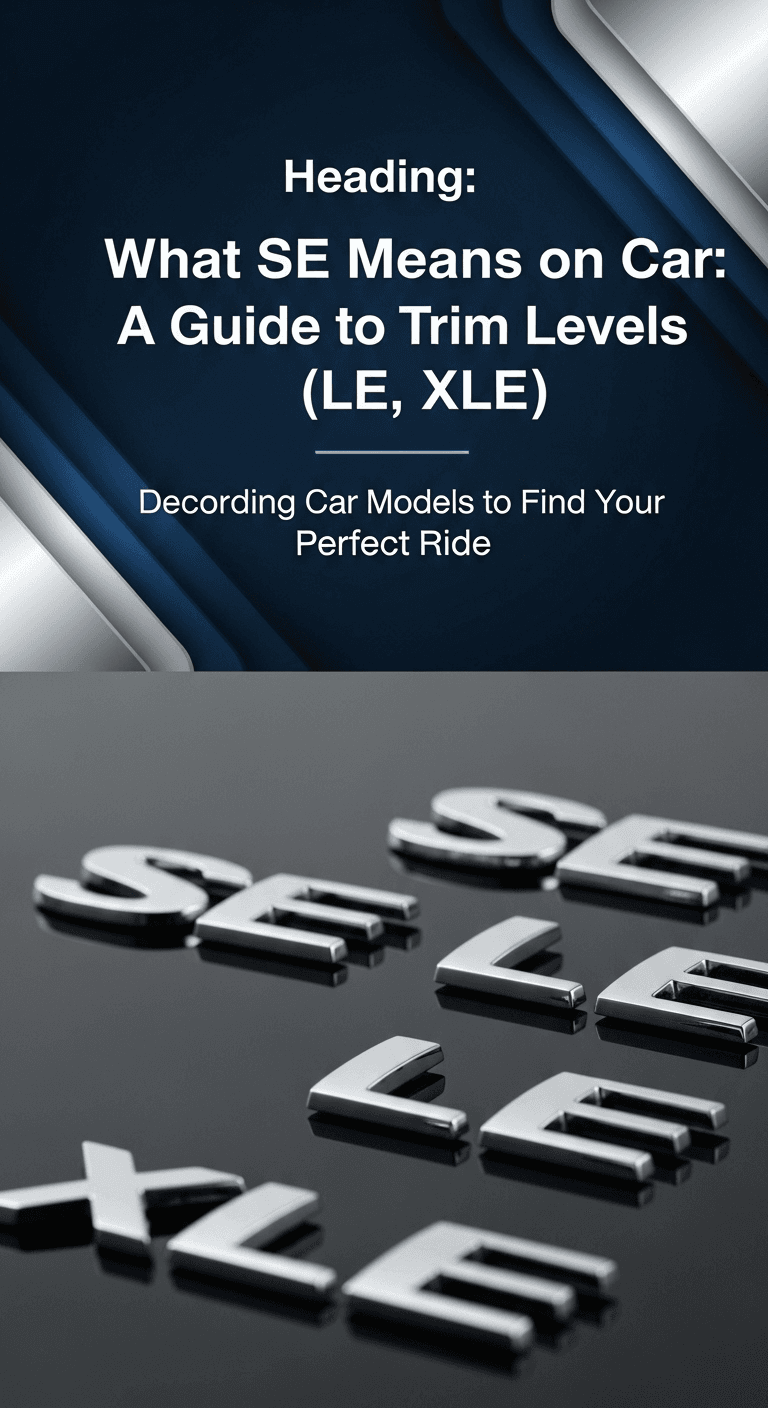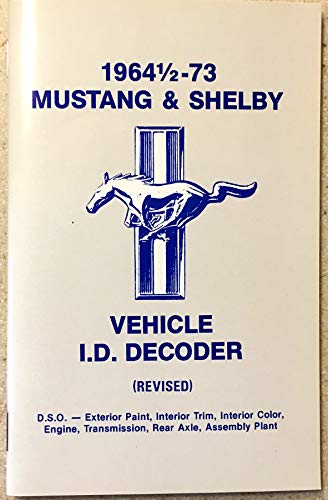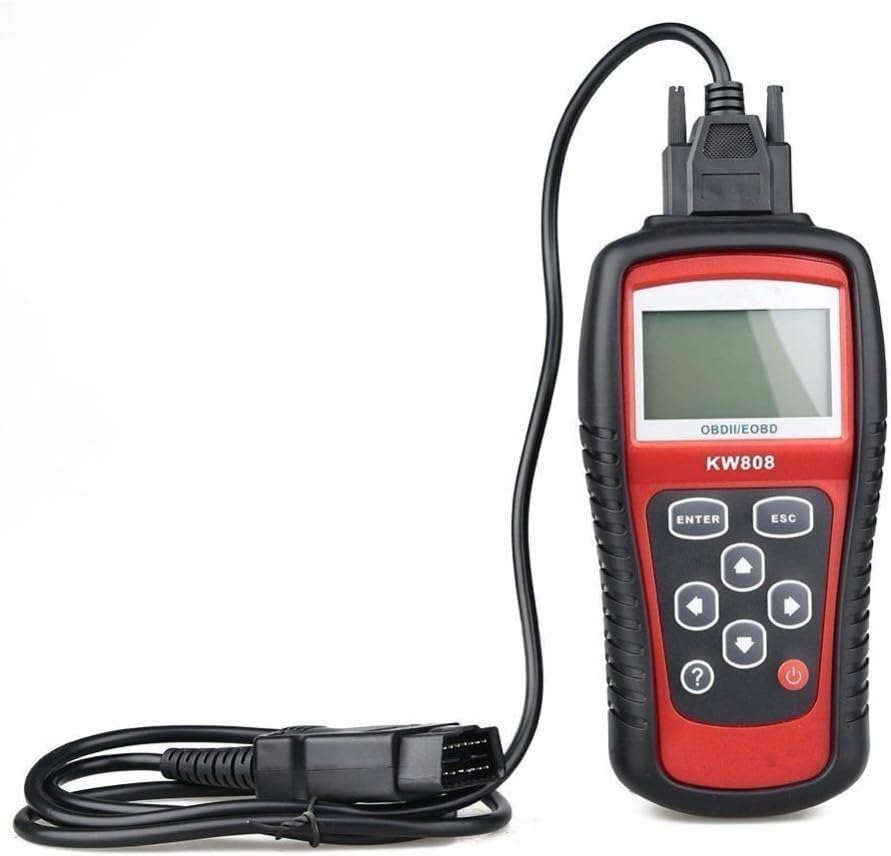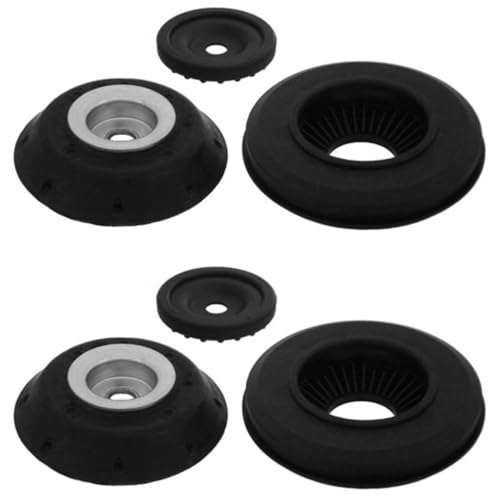Ever found yourself staring at the back of a car, puzzled by the alphabet soup of letters like ‘SE,’ ‘LE,’ or ‘XLE’? You’re not alone. This confusing jargon can make the already stressful process of buying a car even more complicated, leaving you to wonder if you’re missing out on key features or overpaying for a name.
The ‘SE’ on a car most commonly means “Special Edition,” “Sport Edition,” or “Special Equipment,” signifying a trim level that offers more features or sportier styling than the base model. The exact meaning is determined by the specific car manufacturer.
Leveraging extensive analysis of automotive industry data and established patterns, this guide unpacks exactly what does the SE mean on a car. We will decode the three primary definitions, compare the SE trim to other common levels like LE and XLE, and provide a clear glossary for all those confusing acronyms. This will empower you to look past the letters and focus on finding the car with the features and value that are perfect for you.
Key Facts
- Three Core Meanings: The acronym “SE” isn’t a single standard. It most frequently stands for Special Edition, Sport Edition, or, less commonly, Special Equipment.
- Manufacturer-Dependent: The meaning of “SE” is not universal and varies significantly between automakers. For example, data shows Toyota often uses SE for “Sport Edition,” while BMW can use it to mean “Special Equipment.”
- Mid-Tier Positioning: An SE trim is typically a mid-range option. It offers a significant upgrade in features and style over a base model (like an LE) but usually sits below the top-of-the-line trims like “Limited” or “XLE.”
- Not Necessarily Rare: Contrary to what the name might imply, a “Special Edition” (SE) car is not usually a rare or limited-production vehicle. It simply denotes a pre-packaged set of popular features.
- Feature-Focused Value: The primary purpose of an SE trim is to offer a bundle of desirable upgrades—like larger wheels, enhanced tech, or sportier aesthetics—at a price point more accessible than the highest luxury trims.
What Is a Car Trim Level and Why Does It Matter?
A car’s trim level (or trim package) defines a specific version of a model, distinguished by its unique set of standard features, performance, and price, ranging from an affordable base model to a high-end luxury version.

Think of trim levels like different editions of a book—some are basic paperbacks, while others are hardcover special editions with extra chapters and illustrations. For cars, this means that while two vehicles might share the same model name (like a Toyota Camry), their trim levels (e.g., LE, SE, XLE) determine what you actually get. Making an informed purchasing decision requires understanding this fundamental concept. Manufacturers use trim levels to differentiate models based on:
- Exterior & Interior Features: This includes everything from the type of wheels and headlights to the upholstery material inside. Higher trims might add chrome finishes, a sunroof, or leather upholstery, while base models have more basic materials.
- Performance Upgrades: Trim levels can offer different powertrains. A sport-oriented trim might have a more powerful engine, a sport-tuned suspension for better handling, or a more advanced transmission.
- New Technologies: As you move up the trim hierarchy, you gain access to better technology. This can mean a larger infotainment touchscreen, a premium sound system, advanced driver-assistance systems, or a digital instrument cluster.
- Safety Options: While most modern cars come with a strong set of standard safety features, premium trims often include more advanced systems like blind-spot monitoring, rear cross-traffic alert, or a 360-degree camera.
What Does the SE Mean on a Car? The 3 Common Interpretations
The ‘SE’ on a car most commonly means “Special Edition,” “Sport Edition,” or “Special Equipment,” indicating a trim level with more features or sportier characteristics than the base model. The exact meaning depends on the car manufacturer.

So, is every ‘SE’ a race-ready monster? Not quite. Here’s how to tell the difference. Because the term isn’t standardized across the industry, its meaning is entirely up to the brand. An SE on a Ford might offer a different package of features than an SE on a Toyota or a Honda. Understanding the three main interpretations is the key to decoding what you’re actually looking at.
1. Special Edition
A “Special Edition” (SE) trim typically adds desirable features like larger wheels, upgraded infotainment, and better interior materials over the base model, but is not usually a limited-production vehicle.
This is the most widespread meaning of SE. When you see “Special Edition,” think of it as a convenient bundle of popular upgrades. It’s the manufacturer’s way of saying, “Here’s a version with many of the options people want, all packaged together.” It’s designed to be a step up from the entry-level or base trim without forcing you to jump to the most expensive luxury model.
Pro Tip: Don’t let ‘Special Edition’ fool you into thinking it’s a rare collector’s item. Focus on the specific features it adds over the base model. The “special” part refers to the equipment, not its rarity. Common upgrades found in a Special Edition (SE) trim include:
- Larger, more stylish alloy wheels
- Upgraded infotainment systems with larger screens
- Premium sound systems
- Enhanced interior materials, sometimes including leather seats or accents
- Convenience features like remote engine start or multiple driving modes
- All-wheel-drive (AWD) options
2. Sport Edition
“Sport Edition” (SE) signifies a trim with enhanced performance or sportier looks, often including a more powerful engine or aerodynamic styling, and is a common meaning for brands like Toyota and Ford.
If a car has a sporty reputation, there’s a good chance its SE trim stands for Sport Edition. This designation is less about pure luxury and more about delivering a more engaging and aggressive driving experience. The upgrades can be both cosmetic and mechanical. You might find a more potent engine, but you’re just as likely to see styling changes that give the car a more athletic appearance, like a rear spoiler or a more aggressive front bumper.
For many Toyota models like the Camry, ‘SE’ stands for ‘Sport Edition,’ signaling sport-tuned suspension and design elements. This is a clear example from a major manufacturer where SE is directly tied to performance characteristics. Brands like Chevrolet and Ford have also commonly used SE to denote a Sport Edition trim.
Quick Fact: An ‘SE’ on a sporty coupe likely means ‘Sport Edition,’ but on a minivan? Probably not. Context is everything. The type of vehicle is a huge clue to what the SE badge implies.
3. Special Equipment
Less commonly, “SE” can mean “Special Equipment,” indicating the vehicle has specific non-standard components like an upgraded transmission or suspension system, as seen in some BMW models.
This is the least frequent but still important definition of SE. In this context, the trim includes specific mechanical or technological upgrades that are not available on the standard model and might not fit neatly into a “Sport” or “Luxury” category. This could include specific mechanical upgrades like an enhanced suspension system or a better transmission not available on the base model.
This meaning is a catch-all for unique configurations. For instance, data from the automotive industry indicates that for certain BMW models, “SE” is used to signify “Special Equipment,” referring to a package of additional features and upgrades over the standard car, reinforcing that you should always check the specific manufacturer’s definition.
How SE Compares: SE vs. LE vs. XLE
Typically, LE (Luxury Edition) is a comfort-focused base or mid-level trim, while SE (Sport Edition) is a mid-range trim focused on sporty looks and handling. XLE (Executive Luxury Edition) is usually a higher trim with more luxury features than both LE and SE.
One of the most common points of confusion for car buyers is understanding how these similar-sounding acronyms stack up. Using real-world examples from brands like Toyota, where this hierarchy is very common on models like the Camry and RAV4, helps clarify the differences. If you value a sporty design and a more engaging driving experience, the Camry SE is likely the better choice. If comfort and value are key, the LE might be your answer.
Here’s a clear, scannable comparison of their typical positioning:
| Trim Level | Typical Meaning | General Position | Key Characteristic |
|---|---|---|---|
| LE | Luxury Edition | Entry-Level to Mid | Standard comfort features |
| SE | Sport Edition | Mid-Range | Sportier styling & handling |
| XLE | Executive Luxury Edition | Mid to High-End | More luxury & tech features |
This table shows a common progression: the LE provides a solid, comfortable baseline. The SE branches off to offer a sportier alternative, often for a similar price as a mid-level comfort trim. The XLE then sits above them, packing in more premium technology, comfort, and luxury appointments.
A Quick Guide to Other Common Car Trim Acronyms
Beyond SE, automakers use many acronyms like LE (Luxury Edition), XLE (Executive Luxury Edition), GT (Grand Touring), and LX (Luxury) to signal a car’s level of features, comfort, or performance.
The automotive world is filled with a dizzying array of letters and acronyms. To help you become a more informed car shopper, here is a helpful decoder for some of the most common trim level designations you’ll encounter. Think of this as your cheat sheet for the dealership lot.
- CE: Classic Edition or Custom Edition
- DL/DX: Deluxe Edition
- EX/X: Extra
- GT: Grand Touring (often indicates a blend of performance and long-distance comfort)
- LE: Luxury Edition
- LTD: Limited Edition
- LX: Luxury
- SL: Standard Level or Standard Luxury
- SR/SR5: Sport Rally / Sport Rally 5-speed (common on Toyota trucks)
- T: Touring
- TRD: Toyota Racing Development (Toyota’s high-performance trim)
- XLE: Executive Luxury Edition
- XLS: Executive Luxury Sport
The Bottom Line: How to Check a Car’s Specific Trim Features
To know exactly what an SE or any other trim includes, always research the specific model and year on the manufacturer’s website or check the vehicle’s window sticker, as features vary significantly.
Crucial Tip: The letters on the trunk are just a starting point. Always verify the exact features list for the specific car you’re considering. As this guide has shown, acronyms are not universal, and making assumptions can lead to disappointment. Taking a few extra minutes to do your due diligence is the most critical step. This expert advice for car shoppers ensures you get exactly what you pay for.
Here is the best way to verify what’s included in any trim level:
1. Check the manufacturer’s official website. Look up the specific model and year you are interested in. They will have a detailed “specs” or “features” page that breaks down exactly what comes standard on each trim level.
2. Review the car’s original window sticker. If you’re looking at a used car and the original sticker (also called a Monroney label) is available, it is your best friend. It lists all standard and optional equipment installed on that specific vehicle from the factory.
3. Use a VIN decoder service. There are online services where you can enter a car’s Vehicle Identification Number (VIN) to get a detailed report, which often includes the specific trim level and factory-installed options.
To get an even deeper look into a specific vehicle’s history and trim details, using a reliable VIN decoder tool can provide the exact specifications you need.
FAQs About Car Trim Levels
Here are answers to some of the most frequently asked questions about what the SE means on a car and other common trim levels.
What makes a car an “SE”?
A car is designated “SE” by its manufacturer to indicate it has more features, a sportier design, or better equipment than the standard or base model. It is a mid-tier option designed to offer more value without the cost of a top-level trim. The specific package of features that makes a car an SE is determined entirely by the automaker for that particular model and year.
Which is better, SE or LE?
Neither is definitively “better”; it depends on your preference. Choose SE for a sportier look and feel. Choose LE for a focus on comfort and standard luxury features. Typically, the SE is better if you want a sportier design with features like sport-tuned suspension and more aggressive styling. In contrast, the LE is often better if you prioritize comfort and value, usually offering a smoother ride and essential comfort features at a slightly lower price point.
What do SE and SEL mean in cars?
SE typically stands for “Special Edition” or “Sport Edition.” SEL often adds an “L” for “Limited” or “Luxury,” signifying a trim level with even more features or luxury appointments than the standard SE. Think of SEL as a step above SE in the trim hierarchy, bundling the SE package with additional premium options like leather seats, advanced tech, or more comfort features.
Does SE mean the same thing for Toyota, Honda, and Ford?
No, the meaning of SE varies. For Toyota, it often means “Sport Edition” (e.g., Camry SE). For Honda and Ford, it has commonly meant “Special Edition,” though Ford also uses it for “Sport Edition.” Always check the specific brand and model. This highlights the most important rule of car trims: there is no universal standard, and you must research the specific vehicle you are interested in to know for sure.
Final Summary: Decoding Car Trims to Find Your Perfect Match
Navigating the world of car trims can feel like learning a new language, but understanding what letters like “SE” mean is the key to unlocking real value and finding the perfect vehicle for your needs. The confusion surrounding these acronyms is intentional; it’s how automakers cater to a wide range of budgets and tastes. By arming yourself with knowledge, you move from being a confused customer to an empowered buyer.
The most important things to remember from this guide are:
- “SE” isn’t universal: It usually means Special Edition, Sport Edition, or Special Equipment, but always depends on the automaker. It signals a step up from the base model.
- Trims are a hierarchy: They exist to offer different levels of features, performance, and price, from base models like LX or LE to sporty versions like SE and luxury trims like XLE or Limited.
- Always verify: The letters are a guide, not a guarantee. Use the manufacturer’s official specifications and the car’s window sticker to confirm the exact features for any car you consider buying.
Armed with this knowledge, you can now look past the acronyms and focus on what truly matters: finding the car with the right features and value for you. Happy car hunting
Last update on 2025-11-26 / Affiliate links / Images from Amazon Product Advertising API












